Ukraine have experienced a rollercoaster of highs and lows under Andriy Shevchenko’s tenure, much like the 44-year-old’s playing career. From the towering heights of Milan to the dream-cum-nightmare that was his time at Chelsea, since 2016, his first steps into a managerial career have been somewhat unsteady. He took over a squad that finished rock bottom in their unfortunate Euro 2016 campaign, meaning his immediate goal was to reignite the faith back into an ageing squad.
If there is one thing to be said about this squad at least, is that it is reinvigorated. Youth runs amok – acting as the genuine lifeblood of what is good about this current team. Youth in relative terms to this Ukraine squad is probably anyone playing consistently under the age of 25. Viktor Tsyhankov, Vitaliy Mykolenko, and Valeriy Bondar (amongst others) lead what hopes to be a brighter future for the Yellow and Blues.
Performances haven’t always been represented in the results for Shevchenko over the past year or so – working both in and against his favour. While an encouraging display versus Kazakhstan only earned his side a 1-1 draw, the same result occurred just one match prior against Finland in a game where they were constantly backpedalling versus Pukki and co. The boss has utilised different formations to varying success, but most recently a 3-4-1-2 has been the formation of choice – aiming to squeeze the attacking juices out of chief creator Ruslan Malinovskyi in that #10 role.
As a squad, they need to improve their consistency, which is hard to achieve not only as a national team who only play together every so often but also due to Shevchenko’s insistent squad rotation. There seem to be very few players who are guaranteed their starting spot, and it is probably no coincidence that those players are the very few from Europe’s top five leagues.
They will need to hit the ground running at Euro 2020 to make it through to the knockout phases, but against the Netherlands, Austria, and North Macedonia, they stand a decent chance with the squad they have. A handful of friendlies is all they have in terms of preparation in May and June – in this tactical analysis we will take an in-depth analysis at how they’ve been performing across the last 12 months, and what they should do to make the most of their higher-quality individuals.
The Squad
Goalkeepers:
Heorhiy Bushchan
Andriy Pyatov
Anatoliy Trubin
Defenders:
Oleksandr Karavayev
Viktor Korniyenko
Serhiy Kryvtsov
Mykola Matviyenko
Bohdan Mykhaylichenko
Vitaliy Mykolenko
Eduard Sobol
Ilya Zabarnyi
Midfielders:
Yevhen Konoplyanka
Viktor Kovalenko
Ruslan Malinovskiy
Marlos
Mykola Sharapenko
Taras Stepanenko (c)
Serhiy Sydorchuk
Viktor Tsyhankov
Andriy Yarmolenko
Oleksandr Zinchenko
Oleksandr Zubkov
Forwards:
Artem Besyedin
Junior Moraes
Vladyslav Supriaha
Roman Yaremchuk
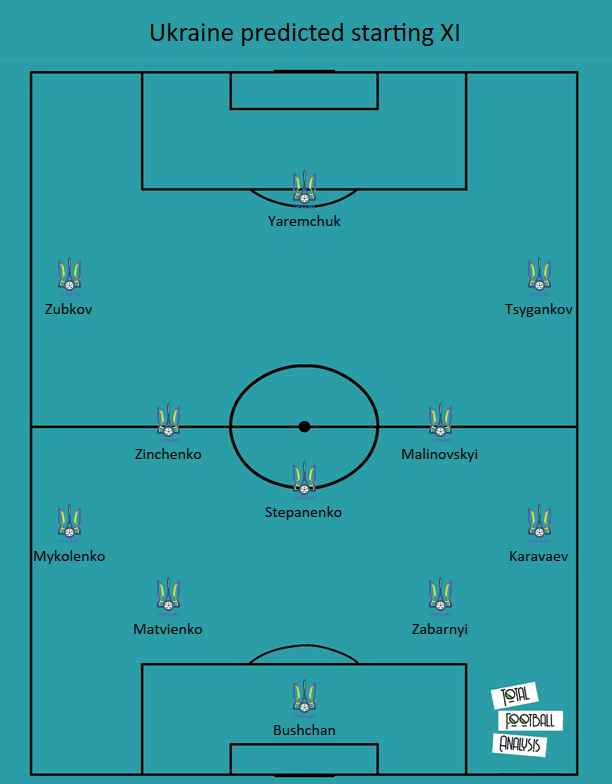
In their most recent matches (the World Cup 2022 qualifiers), Ukraine have been operating with a back three, most frequently in a 3-4-1-2 specifically. However, Shevchenko has had to deal with several injuries throughout the squad which has forced him into a system switch. When the Euros come around, with a couple of weeks of extra preparation due to an early training camp, and what looks to be a fully fit squad, Ukraine should line up in a 4-3-3.
Starting at the goalkeeper, Anatoliy Trubin has been rumoured to become the #1 for Ukraine, but Heorhiy Bushchan has been starting in goal ahead of veteran 36-year-old Andriy Pyatov in recent fixtures at the World Cup 2022 qualifiers. Illya Zabarnyi has broken through at Shakhtar Donetsk at the ripe old age of 18-years-old, and into the Ukraine senior squad subsequently. Lining up with him at the back, Mykola Matviyenko, linked with Arsenal, has become somewhat of a mainstay in the last couple of years at centre-back, so he’s a shoo-in here as well.
The midfield resembles strong squad depth – arguably the strongest starting section of the starting XI too. Stepanenko occupies the deepest midfield role, screening the back four and instigating transitions on his own, laying the ball off safely to Malinovskiy and Zinchenko further up the pitch. Those two are the best players in the squad, with Malinovskiy regularly becoming the fulcrum of this side in terms of creativity. Viktor Kovalenko, Serhiy Sydorchuk, and Mykola Shaparenko add to an already strong midfield as backup options with real talent.
Upfront, Ukraine have an abundance of right-wingers to choose from, but an apparent lack of star quality at left-wing. Oleksandr Zubkov has been starting there recently, but he has never truly shone for the national side, but he will give his all. Yaremchuk has started there too in the past, but now, as a natural goalscoring centre-forward, it will be hard to rip him away from the #9 role. Marlos, Andriy Yarmolenko, and Yevhen Konoployanka are three veteran forwards who will be looking to make their last hurrah a great one for Ukraine as well, with younger talents coming through to replace them, such as Viktor Tysgankov.
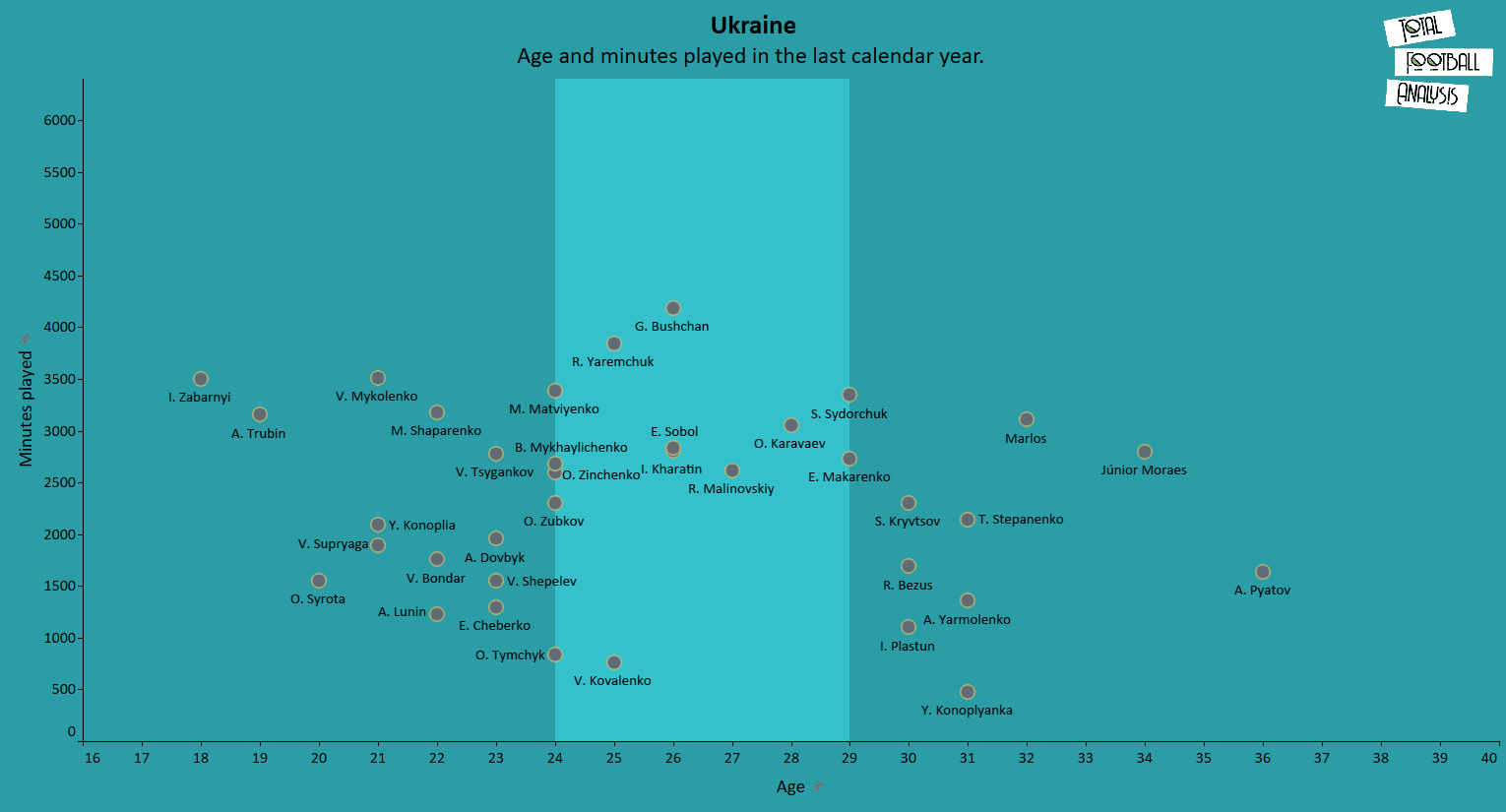
When we take a look at the age of the squad, we can see that Ukraine finally have a good balance. Yellow and Blue stalwarts remain in the form of Andriy Pyatov, Marlos, Andriy Yarmolenko, and Yevhen Konoplyanka, there are a number of players in their ‘peak’ years such as Man City midfielder Oleksandr Zinchenko, Ruslan Malinovskyi, and forward Roman Yaremchuk, as well a few youth talents ala 18-year-old Illya Zabarnyi, Vitaliy Mykolenko, and Viktor Tsyhankov. They may lack the quality compared to many West European teams, but in terms of squad composition, Ukraine are fairly well-balanced, set up perfectly for an incoming tournament.
ATTACKING PHASE
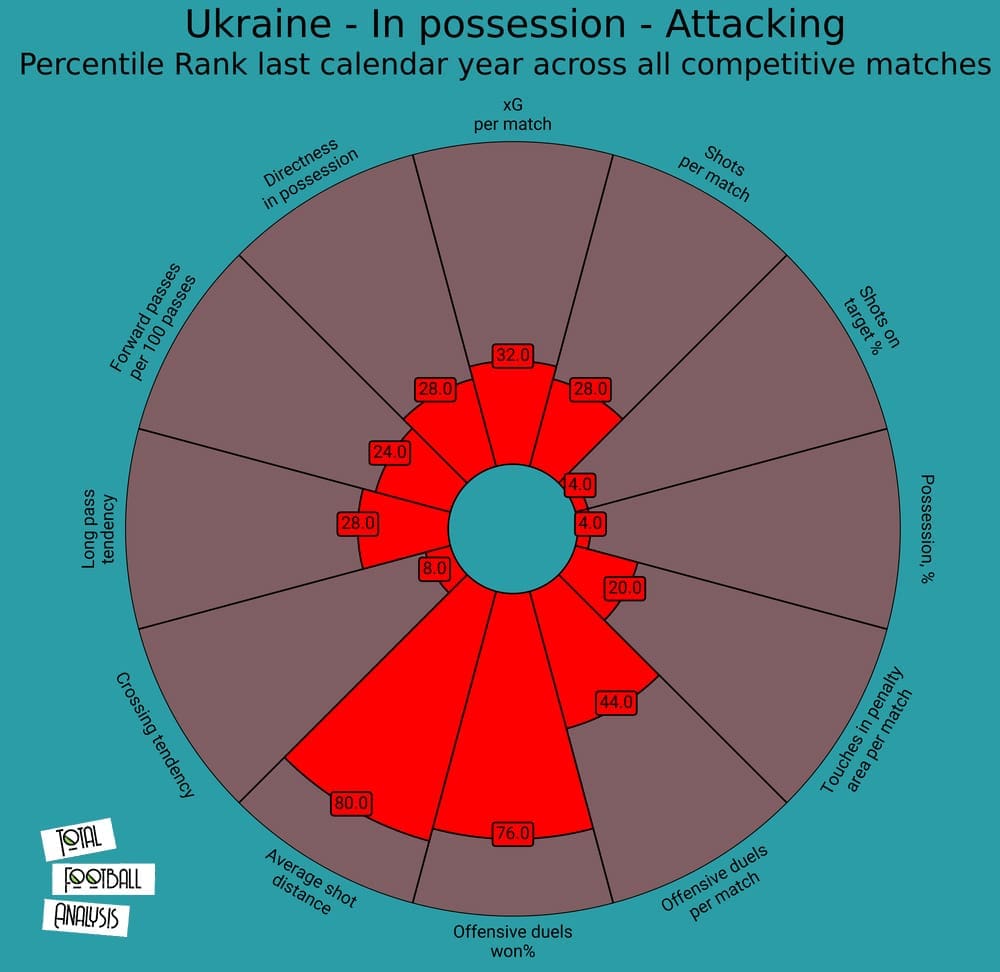
Let’s begin with the obvious: across the last calendar year, Ukraine have not played as much football than the typical year. The pandemic struck, games were postponed, and this team nearly went a year without playing football together. Let’s continue with a less obvious remark: during the period in which Ukraine have started to play matches again, they’ve been crippled with injuries. Key players have always been missing in some shape or form. Now, however, the team looks fully fit, so we can expect better performances than the ones they have shown across the last year.
The attacking radar does not paint a pretty picture at all. This data includes a 7-1 drubbing at the hands of France where they held just 27% possession, an embarrassing 4-0 loss to Spain in which they had 30% possession of the ball, and many more. In these games, they have predominantly played either a 4-1-4-1 or 4-3-3, whilst lacking the quality depth to do so. Against the bigger sides, they’ve struggled to maintain possession, initiate dangerous counters, or even get the ball into the other team’s defensive third.
However, against sides ‘more on their level’, Ukraine have demonstrated their attacking capabilities. They typically build up through the flanks, via the likes of Mykolenko, who will make overlapping runs to create overloads down the half-space and wide zones. The full-back will overlap while the winger will cut inside, waiting to receive the ball within dangerous areas. Ukraine’s inside-forward’s score a good proportion of their goals on the international stage, which was demonstrated in their huge 5-0 victory versus Serbia in 2019, arguably Tsygankov’s best game for the Yellow and Blues.
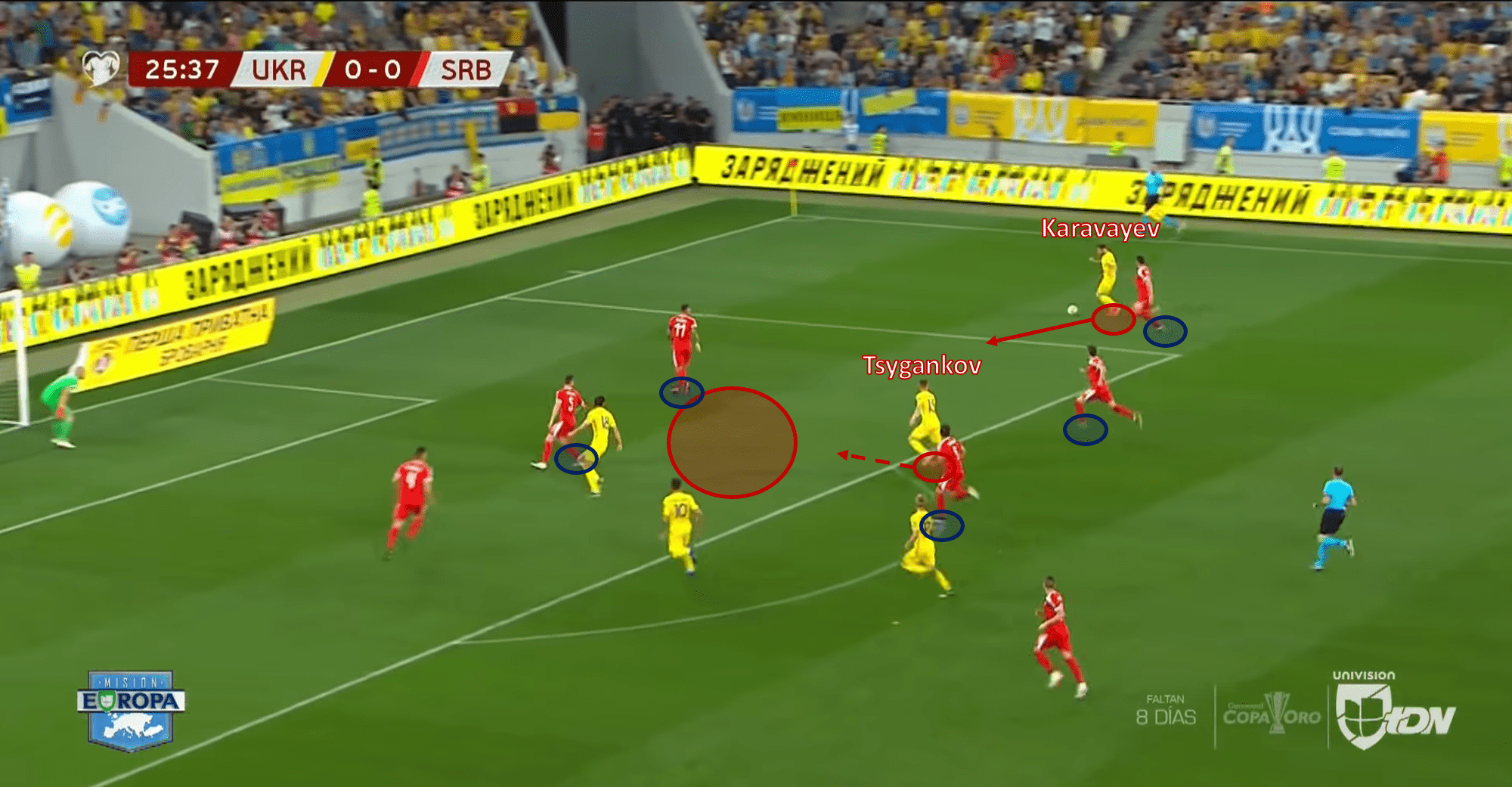
Karavayev has made the overlapping run down the right flank, while Tysgankov has managed to ghost inside the box for a deft finish into the bottom left.
Ukraine do not typically attack down the centre of the pitch in a 4-3-3, but in their most recent matches where they have utilised a 3-4-1-2, with Malinovskiy operating as the #10, the primary attacking goal is to get the ball into the feet of the attacking midfielder. In their most recent matches, there has been somewhat of an over-reliance on the Atalanta player, but he does provide the most moments of magic in the final third, with an ability to create something out of nothing from his nifty dribbling in tight spaces.
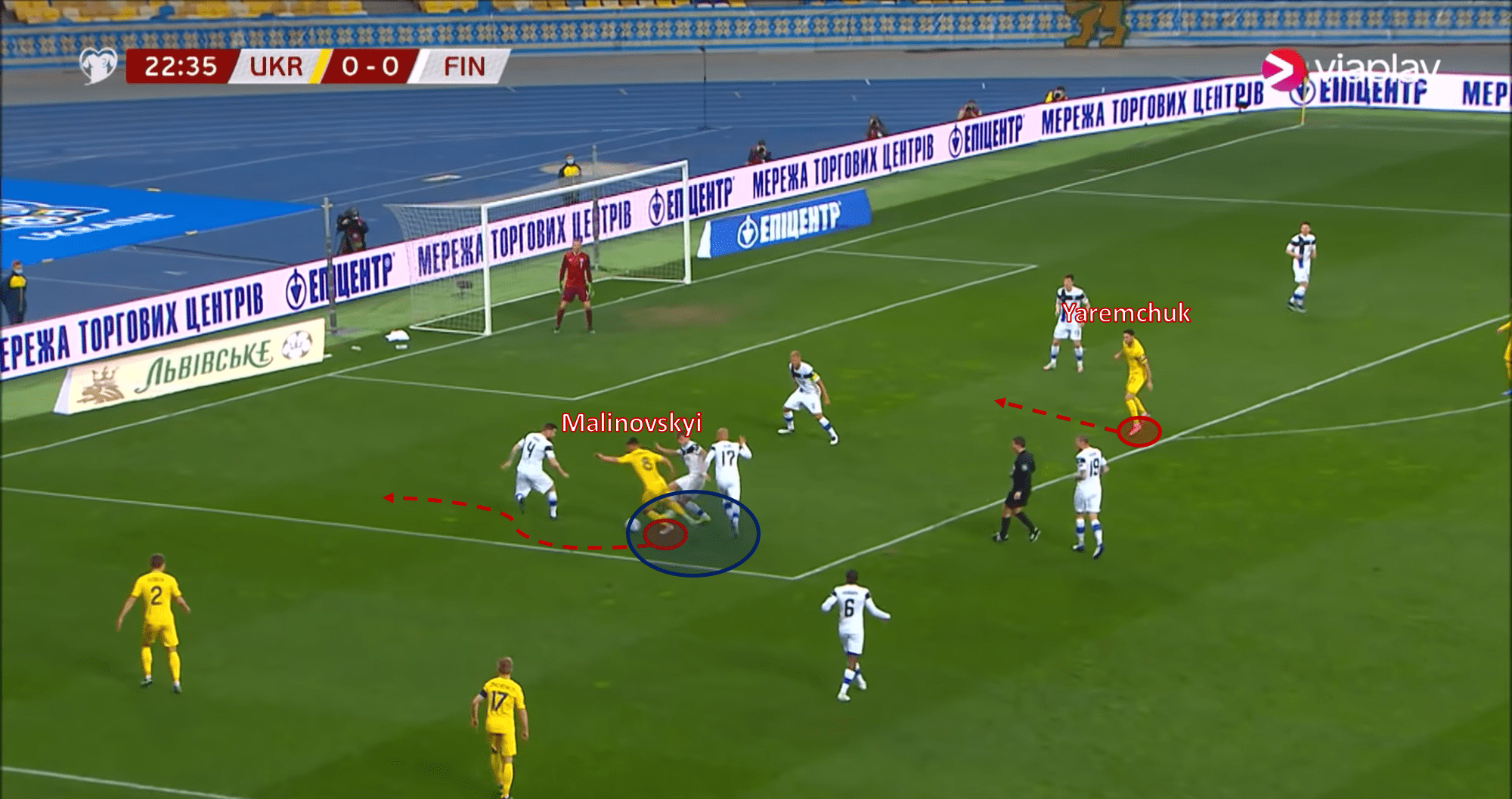
Neat and tidy in tight spaces: Malinovskyi makes his way past three Finland players down the half-space and can send a good delivery towards Yaremchuk.
DEFENSIVE PHASE
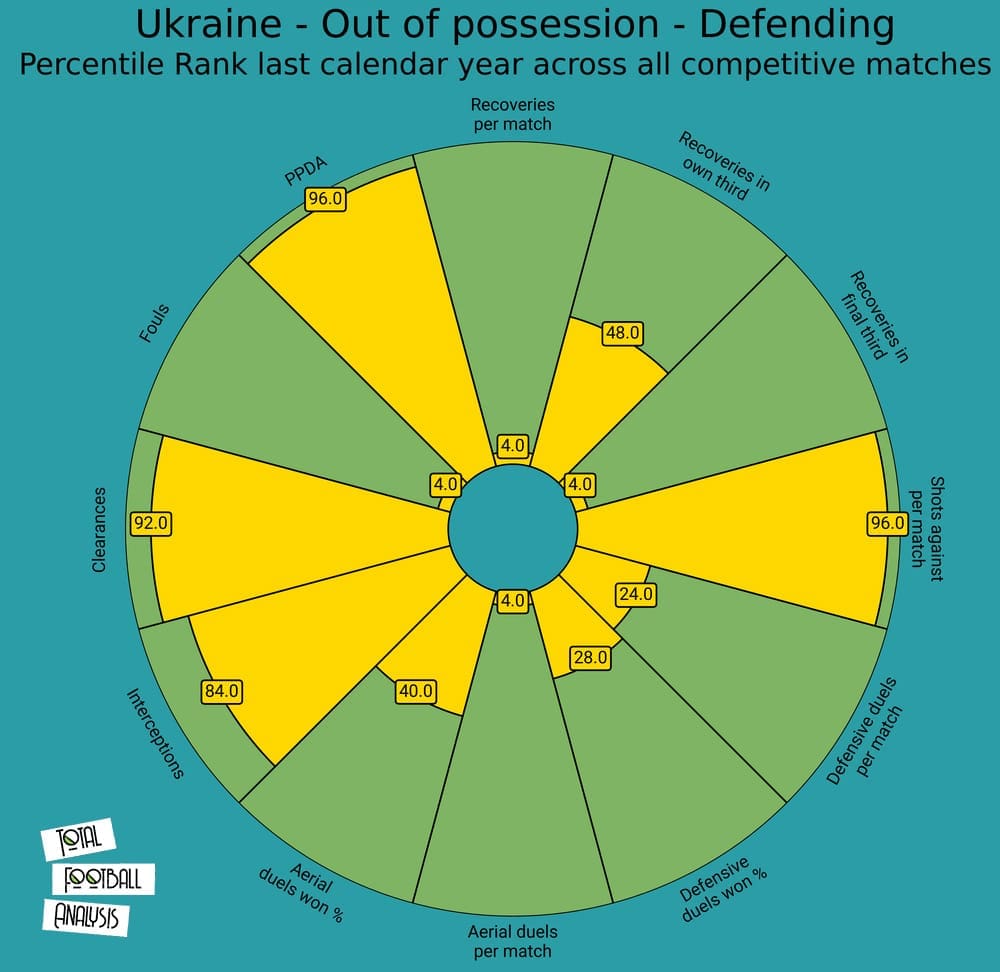
Again, from a defensive perspective here, it does not look so brilliant either. They rank highly where you would like to rank lowly, and they rank lowly for where you want to rank highly. Let’s begin with the PPDA (passes per defensive action), which sits in the 98th percentile for all national sides in the dataset. Coupled with a lowly 4th percentile for recoveries per match, we can begin to gauge an understanding of how Ukraine like to defend. Employ a low block, especially against some of the tougher sides, and attempt to block the ball – Burnley style.
Now, this actually changes when Ukraine face teams that are not Germany, France, or Spain. Against teams that they can hold a candle to, Ukraine like to initiate turnovers in midfield to spark dangerous transitions and exploit some of the gaps as a result. Stepanenko is especially important for this, typically holding his position in the base of midfield, screening from left to right, cleaning up any loose balls and harrying his opponents like nobody’s business. His main passing options are to the two midfielders on either side of him who can progress the ball further up the pitch.
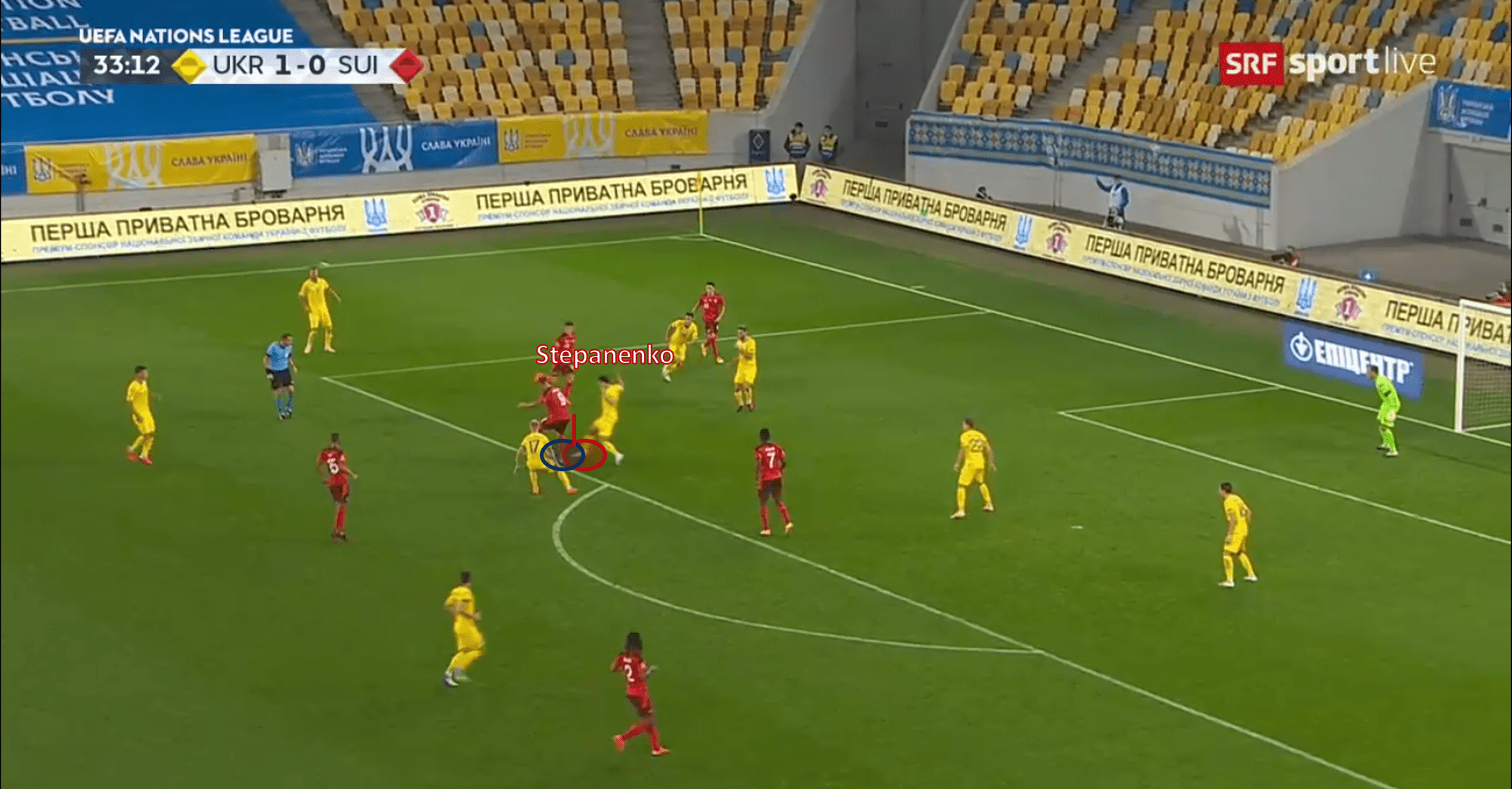
Stepanenko wins the ball back here in a dangerous position for the opposition, and he can lay off the ball to a nearby teammate.
Depending on their opponent, and the formation that Shevchenko uses, Ukraine’s wingers will also get involved defensively if the situation demands so. If a team like to attack down the half-space, the wingers for Ukraine will consistently track back and assist their fellow full-backs in regaining possession, often making for a 7-3-1 formation if Shevchenko opts for a back three/five. In recent matches, it seems as if the 44-year-old coach has been trying to develop a strong basis to build from defensively, given their weak displays over the last calendar year, almost like a system reboot. In that case, we could see the back three at the Euros, but with all their key players back in business, it is unlikely.
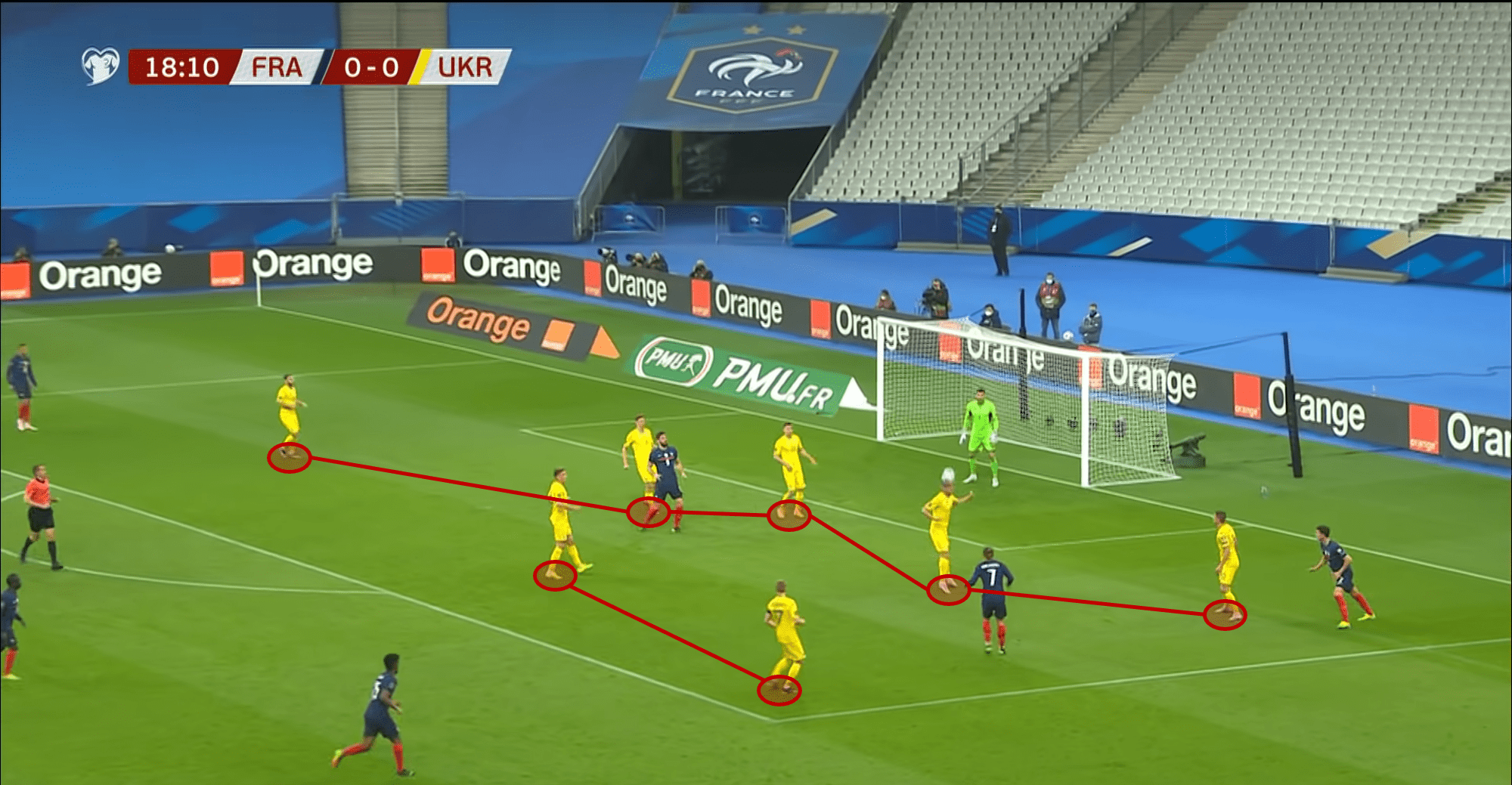
France on the attack here – just as Ukraine clear the ball out, notice their back five and two holding midfielders in the box, protecting the goal.
We can also see from their statistics the results of a low block. They remain in the 92nd percentile for clearances, which makes sense given how busy they are in their defensive third for a lot of the matches in this dataset against bigger sides. Their high percentage for shots conceded per match does, however, need to drop significantly at the actual Euros tournament. Conceding that high number of shots to a side like the Netherlands, who they face in the group stages, could be devastating if their forward ensemble are in form.
TRANSITIONS
In the transition, Ukraine could make the most of their quicker attackers when they face up against the Netherlands – their sternest opponent in the entire group. We know that the Dutch will play with a high line under Frank De Boer, so exploiting that will be crucial to Ukraine’s success. Players such as Tsygankov, Yaremchuk to an extent, and Zubkov will need to be on the nose of the Dutch defenders to stand a chance of success.
Ukraine under Shevchenko most frequently initiate transitions from midfield, with any one of the three midfielders recovering possession, but usually, this is up to Stepanenko. Once the ball is won, Yaremchuk is typically waiting upfront to receive the ball with his back to goal, given his big physical presence. This will draw the attention of potentially two defenders, creating room for one of Tsygankov or Zubkov to make the run into space, where they can be found with a neat through pass.
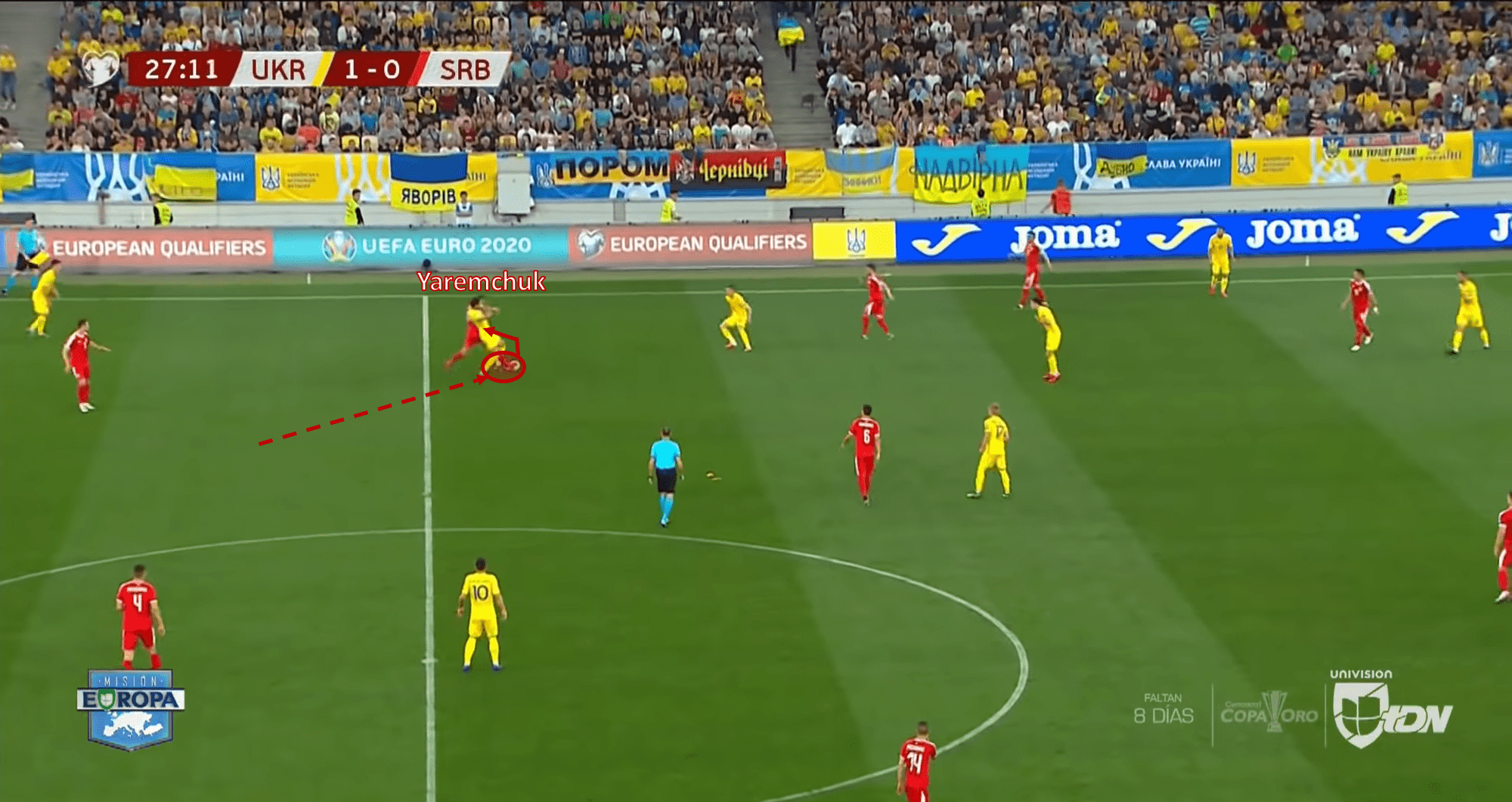
Indicative of the defensive responsibilities instilled into each player, Yaremchuk here drops back into midfield to win the ball back to instigate a turnover.
Although, if the ball is won back from one of the wider central-midfielders in a 4-3-3, the idea is to find one of the inside-forward’s immediately with a through pass to match their movement in behind. From there, they can enter the penalty area and have two goal-scoring options, go for goal by themselves, or find Yaremchuk in the box who should have caught up by this point, in prime position to receive the ball and score.
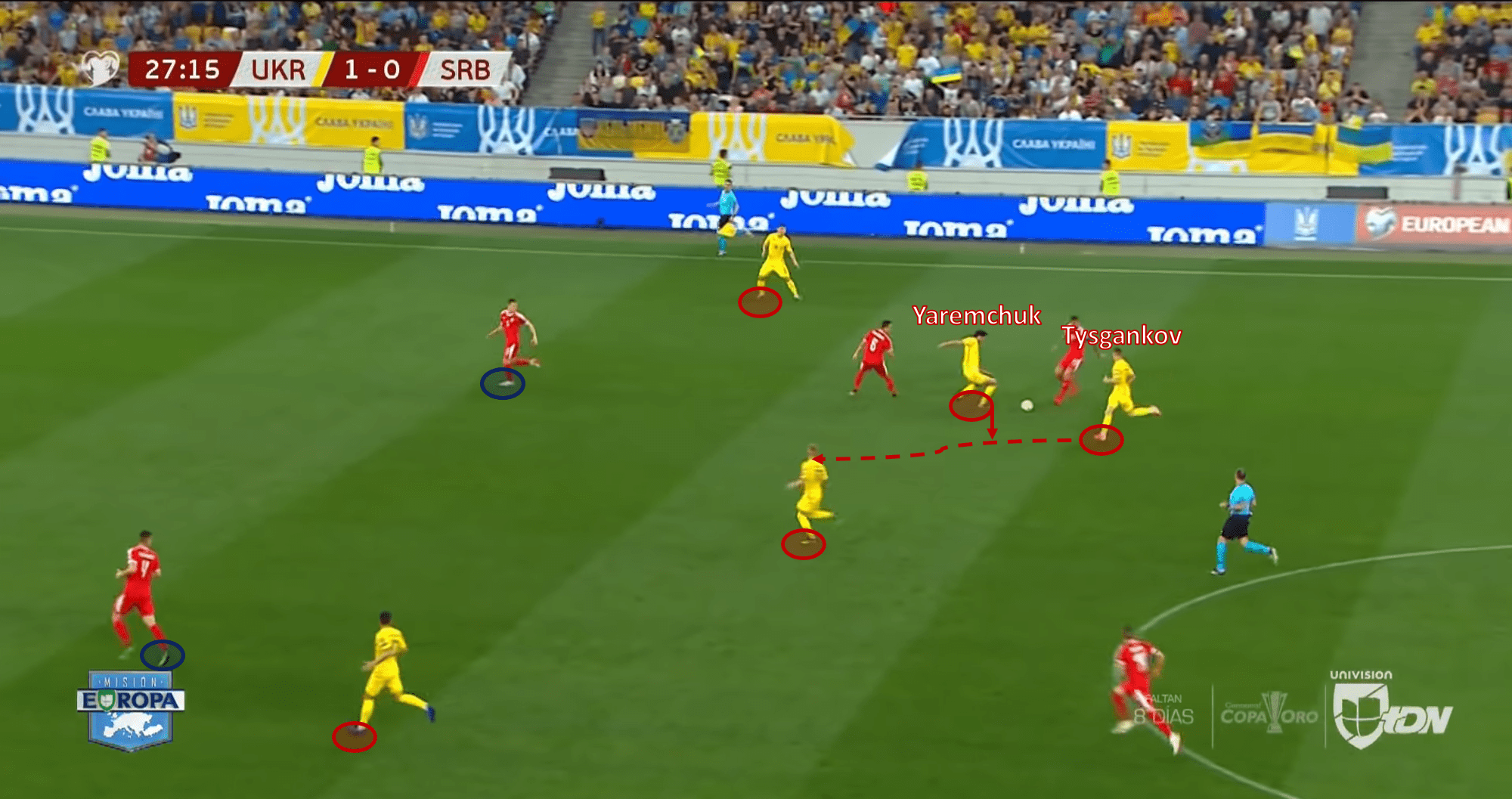
Yaremchuk lays the ball off here to Tysgankov in support, who can drive up the pitch to create a 4v2 scenario in Ukraine’s favour.
FORWARDS
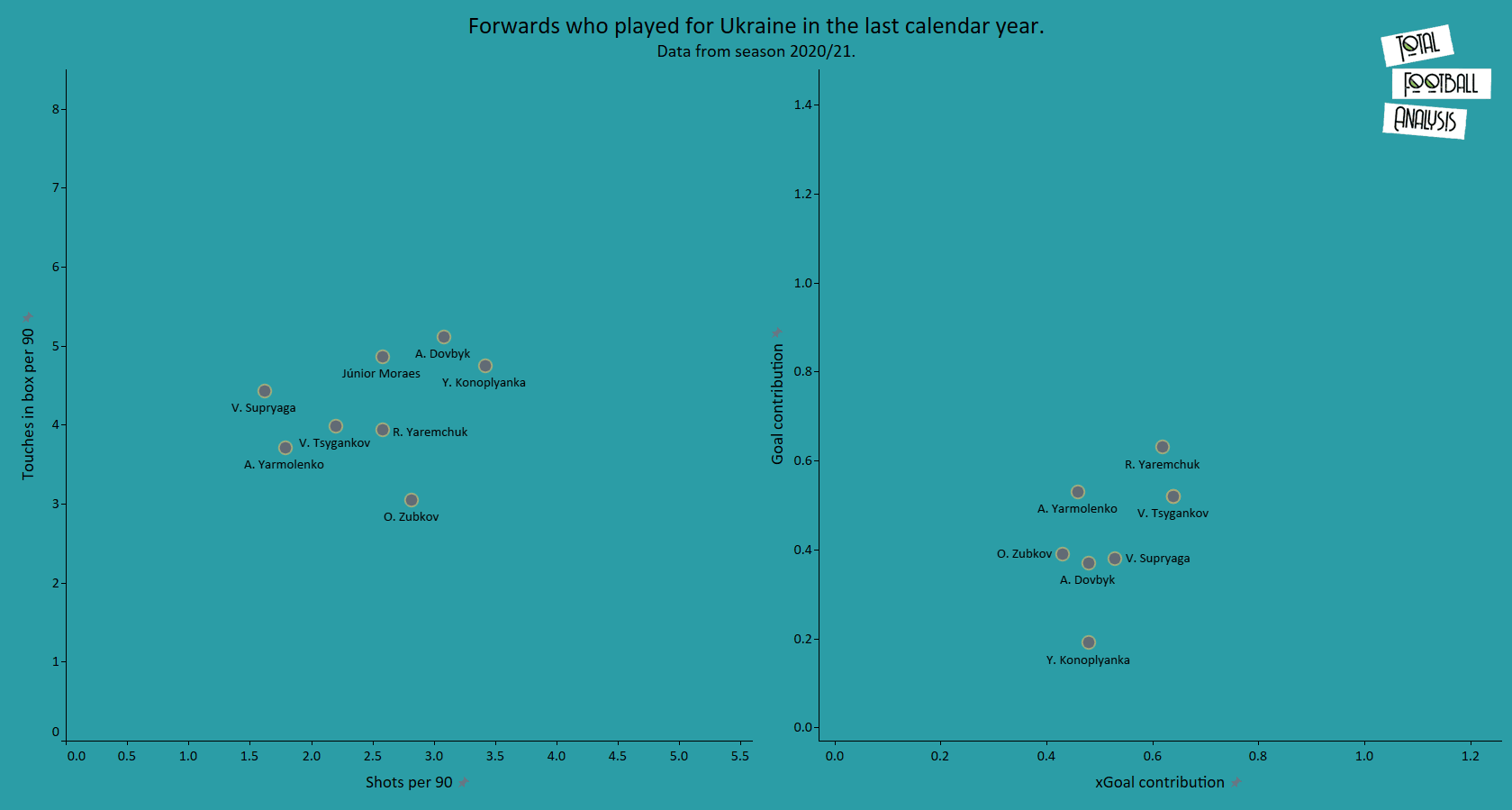
When we look at the statistics of Ukraine’s forwards, they generally come across as rather middling. Some of the better players in the database, the likes of Robert Lewandowski and Lionel Messi blow these statistics out of proportion somewhat, making good players look slightly worse. This is the case with our selection of attackers here. Let’s take Tsygankov as one example: 12 goals and 8 assists in 1300 minutes of league action is a phenomenal return – further evidence of how far he has outgrown the Ukraine league. Another shining example, Roman Yaremchuk at Genk, the first consistent Ukrainian goalscoring #9 since Shevchenko himself. 17 goals, 6 assists is the cherry on top of the 6’3” pie of a striker who contributes so much more than just goals to his team.
Outside of those two players though, there is genuine cause for concern. The main area of worry is the lack of a natural left-winger with decent current ability. Yevhen Konoplyanka was a genuine talent once upon a time, especially for Ukraine, but it is generally agreed that his time to shine has come and gone. Oleksandr Zubkov suits the role to the greatest degree, and will certainly work diligently for his side, but at 24-years-old, really has lacked the output one might expect of him at this stage of his career. Alternatively, Tysgankov and Yaremchuk have played at left-wing for Ukraine previously, leaving room at striker or right-wing for veteran Marlos, who does not make these graphs due to lack of data this season.
Although not listed as an attacker, it should be noted that Ruslan Malinovskiy as an attacking midfielder has contributed to goals at Atalanta at a rate of 0.89 per 90. Combine this with his recent performances for the Yellow and Blues and we have a player who can contribute to goals at a high rate from midfield, an extremely useful asset to have, which we will cover in more detail later.
MIDFIELDERS
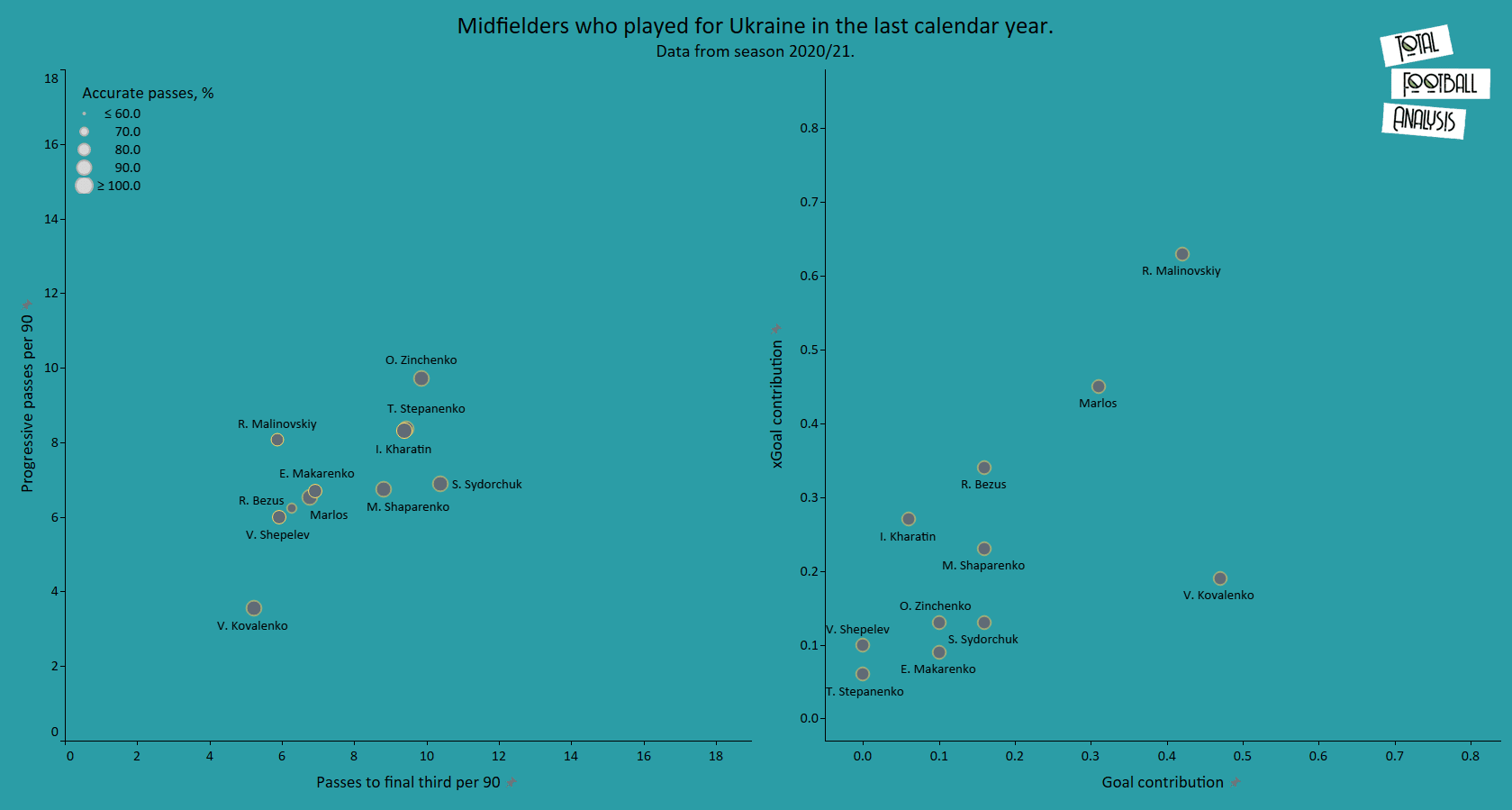
In terms of ball progression, Ukraine have a few noteworthy individuals who are capable of breaking the lines with their passing. It should come as no surprise that Zinchenko of Man City leads the way for Ukrainian midfielder’s progressive passes. For Guardiola’s team, he has primarily featured as a left-back over the last few seasons, but he has been given his opportunities at centre-midfield as well. That’s where he will play for Ukraine too. He will not be the chief creator, but as a #8, he will link the midfield to attack capably.
At the base of midfield, Stepanenko’s role will be to first and foremost screen the backline – but he also has the ability to progress the ball up the pitch too. To label him as a destroyer might be a discredit to his abilities. He’s not quite a modern #6, nevertheless, his passing range does go somewhat under the radar. Outside of those two names, Serhiy Sydorchuk pops up as an attacking passer, with a good number of passes into the final third per 90.
Moving onto goal contributions, as we mentioned, Malinvoskiy outshines them all in this regard. Marlos and Vikor Kovalenko also produce a decent number of goal and expected goal contributions for their respective sides too, although poor Kovalenko has barely had any time to shine since his January move to Atalanta. Again, outside of these players, the rest do not stand out from an attacking perspective.
DEFENDERS
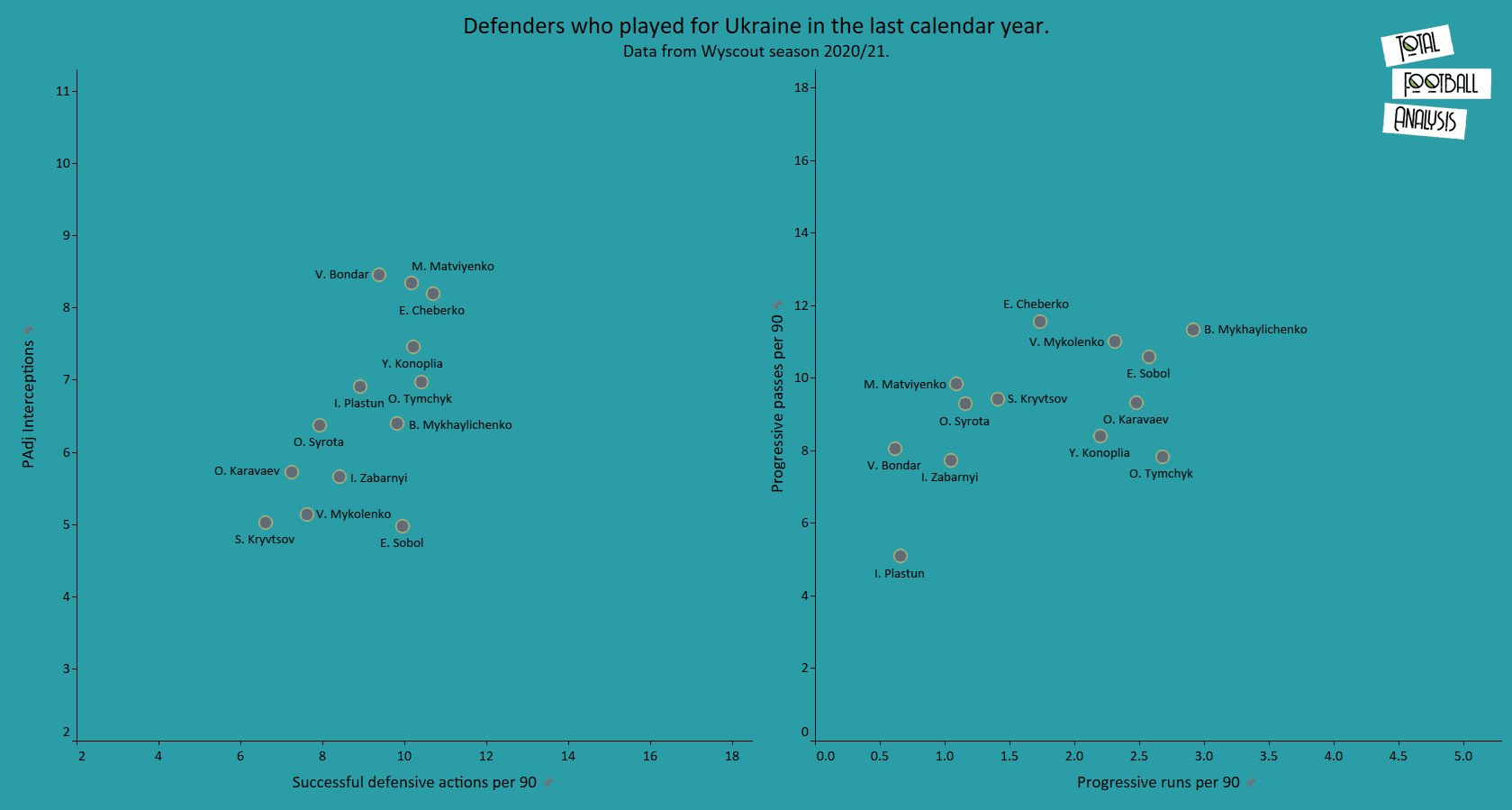
Now, if there is one thing that Eastern European sides are credited for: it’s their solid defensive capabilities. Russia, Poland, and Ukraine have all been applauded for their defensive stalwarts in the past (Akinfeev, Fabiański, Pyatov, amongst others…). In 2021, how do the Yellow and Blues stack up in this regard?
Well, for one thing, there are a number of young Ukraine defenders breaking through at senior sides across the Ukrainian league. There is a widespread shock that Mykolenko at Kyiv hasn’t left the country for a top-five league yet, Denys Popov the same, Valeriy Bondar has suffered unfortunate injuries, and Zabarnyi has experienced a rapid ascent to the top level before the age of 19. There is plenty of promise for the future defensively for Ukraine, while some of them aren’t ready now, the hope is that they will be, come the next tournament.
Statistically, Ukraine do have some rather active defenders by the look of their interceptions and successful defensive actions. Bondar, Matviyenko, and Yevhen Cheberko all respectively rank highly for PAdj interceptions per 90, identifying that they somewhat regularly step out of their defensive line to block passing lanes, which demonstrates a level of defensive intelligence. None of the listed defenders are overly active from a successful defensive actions perspective, but if we consider the context, many of these players are representing some of Ukraine’s best teams, who will have a high amount of possession each game, so I’m sure if these stats were possession-adjusted, they would come across potentially even better.
When it comes to ball progression, the expected names come up – Mykhaylychenko is rated highly here playing for Belgian side Anderlecht, playing the line breaking passes you might not expect from a left-back. Mykolenko and Sobol also rank highly here, which again makes sense considering their positions and team’s that they represent. One noteworthy comment to make here is that the majority of Ukraine’s centre-backs are fairly conservative here in terms of progressive passes and runs. Defend first, play later is the principle of many Ukraine teams over the years, so it seems like the ball progression responsibility will be laid upon the full-backs at the Euros.
BEST PERFORMER
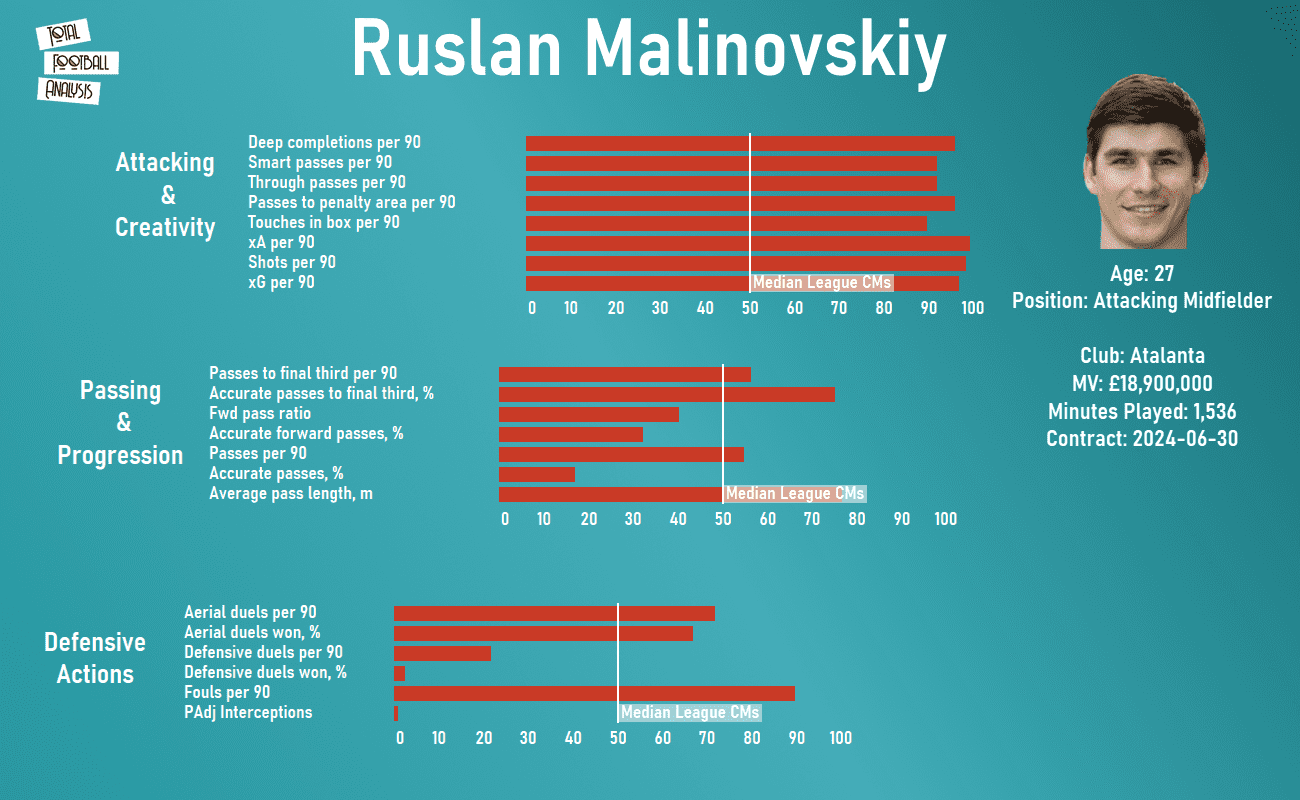
The message should be clear and obvious by now: Malinovskiy is the fulcrum of this side from an attacking sense, and this output is also translated into league play too. With Atalanta, he is not a guaranteed starter, regardless, his underlying numbers have been spectacular for a couple of seasons now. A brief look at his attacking and creativity numbers make this abundantly obvious. He ranks in the 90th+ percentile for every statistic listed as an attacking midfielder, apart from touches in box per 90, which he ranks slightly beneath for. It is worth noting he does play for Atalanta, an overtly attacking side who are willing to leverage some defensive mishaps in favour of more attacking endeavours, as such, boosting Malinovskiy’s numbers.
From a passing & progression perspective, Malinovskiy underwhelms and overperforms simultaneously. According to fbref.com via StatsBomb data, Malinovksiy ranks in the 99th and 94th percentile for progressive runs and progressive carries with 7.47 and 9.32 respectively across the last 365 days compared to attacking midfielders / wingers in Europe’s top five leagues. Truly a dual-threat capable of breaking the lines and carrying the ball into dangerous areas with frequent success. However, his forward pass ratio remains below average, suggesting in a team which are less dominant in an attacking sense, such as Ukraine, Malinovskiy may struggle more in this regard somewhat.
Defensively, somewhat understandably, Malinovskiy lacks in terms of output. He is not a defensively active attacker, but at Atalanta, their forward’s aren’t in general. Gian Piero Gasperini asks his men to hold the shape of the formation and cut off passing lanes, rather than aggressively press the ball carrier. With that being said, his success rate is poor, but if it isn’t something he works on intently at training, then why would it be a positive trait in an already blossoming skillset. Given Malinvoskiy is 5’11” / 180cm, his above-average aerial abilities are impressive, to a certain extent. Depending on which team he is up against in midfield, he can be up against smaller, nimble midfielders, or tall, physically combative players.
PREDICTIONS FOR THE TOURNAMENT
Ukraine are yet to get out of the group stages in a Euros tournament, but this year they have the chance to rectify past mistakes. People may only remember their embarrassing 7-1 defeat to France, as such, people may underestimate some of the legitimate strengths of this squad. If they turn up in their 2019 form, Ukraine could enter this tournament as dark horses. Faith remains in Shevchenko as a capable coach, he’s made errors in the past, but in his 5th year at the helm, he might just guide this team out of the group stages, potentially to a quarter-final finish, which would represent a great success for them.

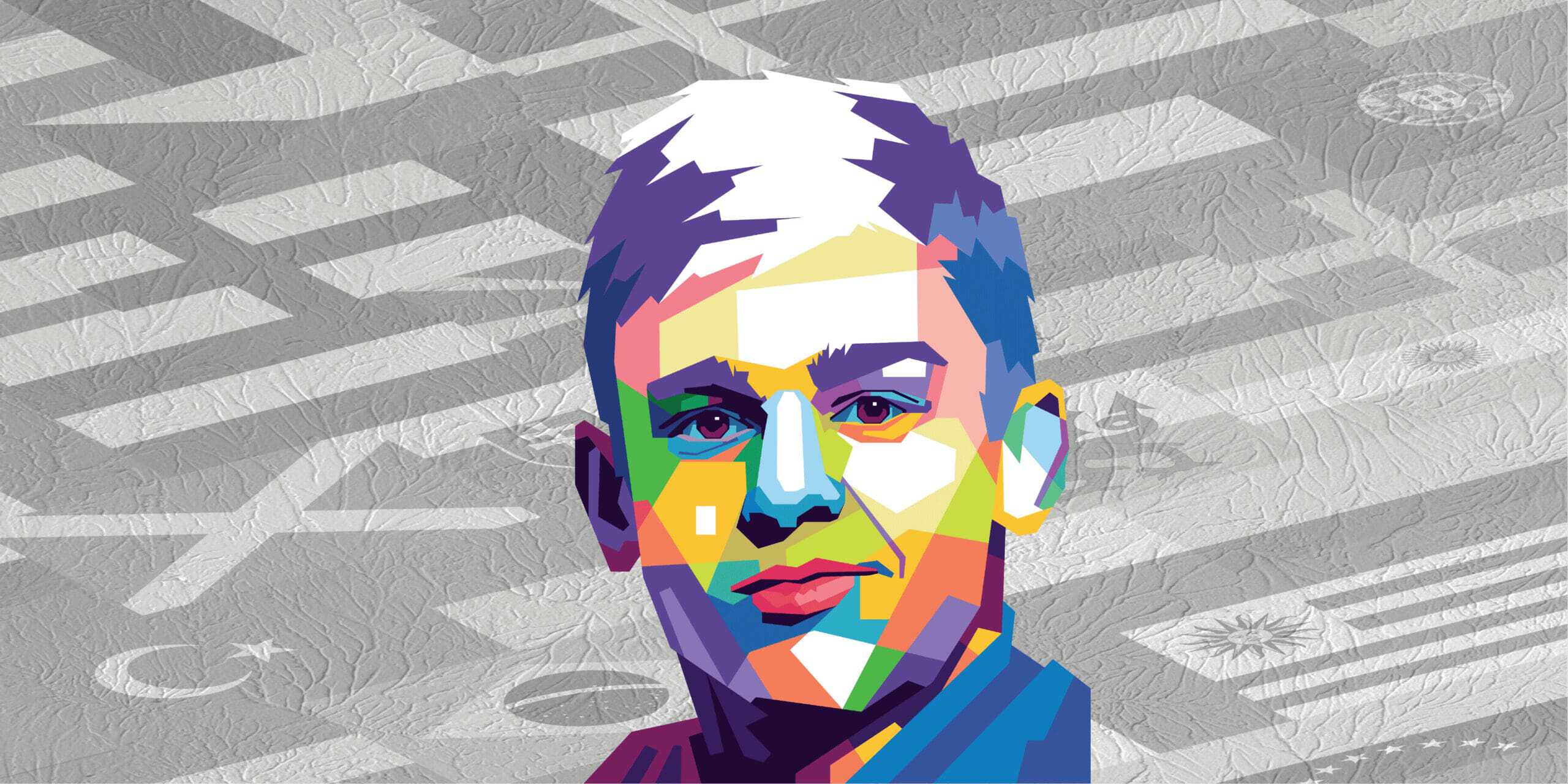



Comments